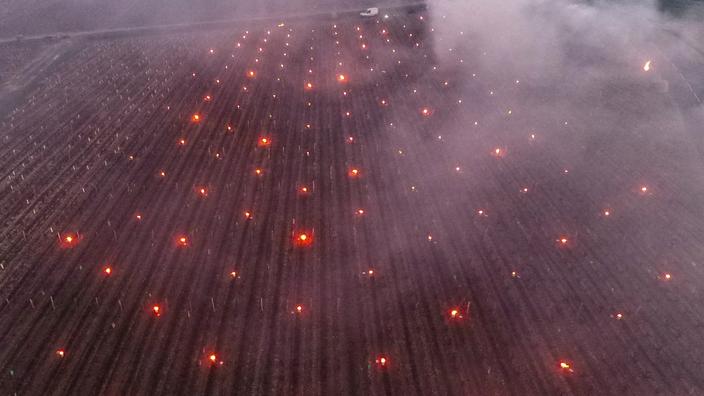After several days in good weather, France was invaded by a devastating cold snap this week.
Many wine-growing areas, which had seen their vines bud early due to the mild temperatures, were suddenly devastated.
And this, despite all the efforts of the winegrowers to protect the buds from the bite of the cold.
According to Jean-Marie Barillère, president of the Cniv which brings together the interprofessions of PDO and IGP wines, the frost has affected "
80% of the French vineyard
".
Read also: At the bedside of the vineyards, a nightmare of fire and ice
The operators know it: the season will not be good after this dazzling and devastating episode.
The State nevertheless came to their aid, since the Minister of Agriculture Julien Denormandie announced this Friday, April 9 the opening of the Agricultural Disaster Fund, promising "
to ensure that no one is left behind.
The next day, Prime Minister Jean Castex hammered home the point by announcing the release of “
exceptional
”
aid envelopes
, but also the removal of the ceiling from the Calamities Fund.
This Fund therefore plays a central role in compensating operators in the event of extreme weather episodes, which will multiply in the years to come due to climate change.
How does it work ?
What does it give access to?
Le Figaro
takes stock.
Uninsurable damage
The Agricultural Disaster Fund is “
complementary and exclusive
” to insurance, ie it cannot be invoked if the damage suffered by the farmer can be covered by his insurance.
In addition, for the Fund to be activated, it must be possible to demonstrate that the damage was caused by an “
exceptional
”
climatic phenomenon
: it must therefore not be frequent, and must be extensive.
So far, the fund has often been invoked in cases of droughts or floods.
Once released, the Agricultural Disaster Fund will compensate two types of losses: crop losses and losses of funds.
The operator who wishes to benefit from it must prove that the loss exceeds several regulatory thresholds:
Losses (crop or fund) must be greater than 1000 euros.
The rate of physical loss must be greater than 30% of the theoretical annual harvest.
The amount of losses exceeds 13% of the theoretical gross product of the operation.
Where does the money come from?
This fund is supplemented in several ways.
First of all, it is the National Risk Management Fund (FNGRA) which is requested to provide funding.
The FNGRA receives professional contributions, and more particularly a tax of 5.5% on compulsory insurance.
This contribution is capped at 60 million euros per year.
Then, it is the State which supplements with subsidies up to the needs in the event of major climatic disasters.
Chambers of Agriculture France (the Permanent Assembly of Chambers of Agriculture - APCA) specifies that 150 million euros could be donated to farmers affected between 2000 and 2013 through this Fund.
Read also: Corsica: part of one of the largest wine estates attributed to 25 young farmers
Chambers of agriculture however underlines the limits of this device: the compensation rates are for example limited, which this time obliged the government to release “
exceptional
”
envelopes
for the wine growers.
In addition, the payment of aid from the Fund may take several months.
What destabilize the financial balance of producers.
This Friday on franceinfo, the president of the FNSEA Christiane Lambert called on the government to accelerate the compensation procedures, arguing that after the drought episode last year, the money had only been received "
nine months after
”by farmers.

